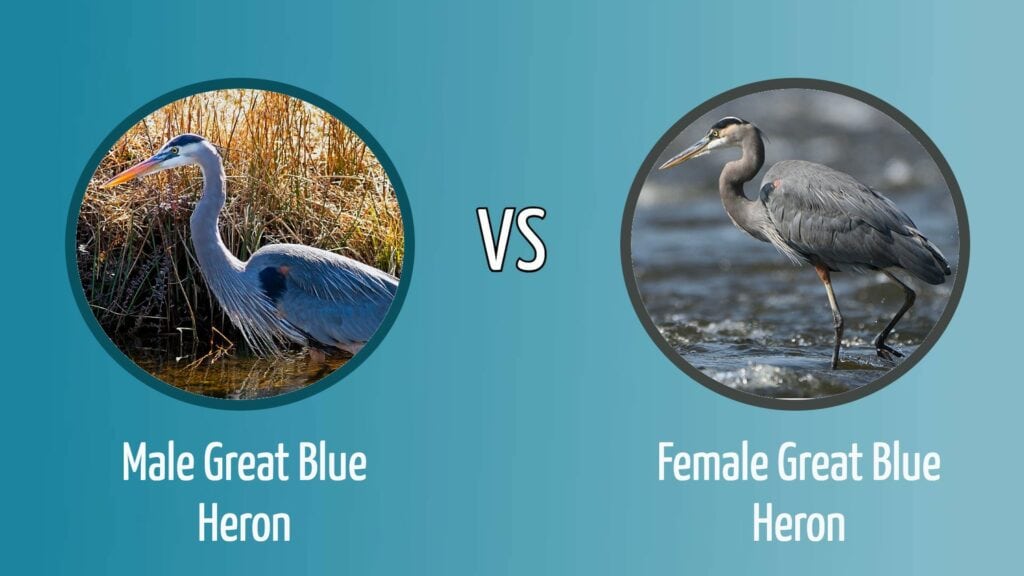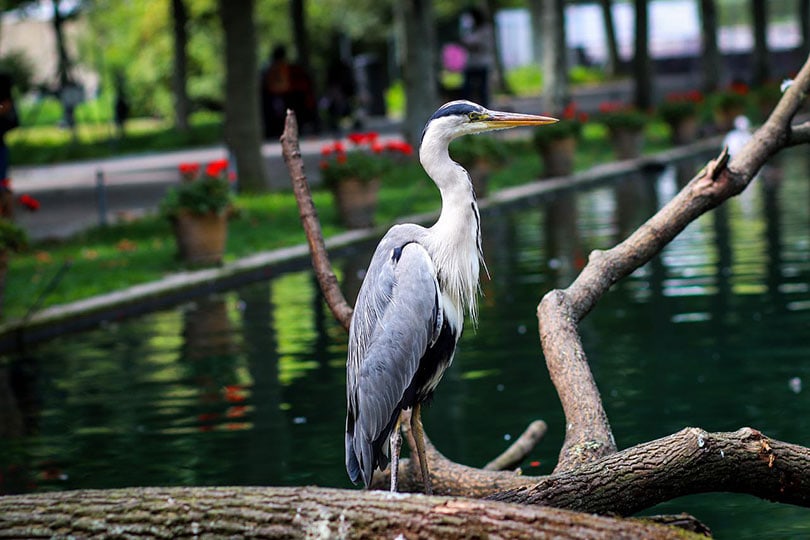Great Blue Heron Male vs. Female: How to Tell the Difference
Last Updated on

The Great Blue Heron is the largest species of Heron in the US and gets its name from its gray-blue plumage. They are found throughout North America and are exceptionally skilled at fishing, and their size makes them difficult to miss, even when they are standing perfectly still hunting for fish. The Great Blue Heron’s diet does consist primarily of fish, but this incredible bird will also eat some insects and small animals. While it is very difficult to spot the difference between male and female great blues from a distance, it is easier to tell them apart from up close.
Below, we discuss more details of the species and how to tell the genders apart.

Visual Differences

- Average height (adult): 50–54 inches
- Average weight (adult): 6–8 pounds
- Average height (adult): 36–40 inches
- Average weight (adult): 4.5–6 pounds

About the Great Blue Heron
The Great Blue Heron is a large heron species that can grow to 50 inches or taller and weigh as much as 8 pounds. It is a wader and can be seen on the shores of waterways across the country. They hunt by standing still or walking very slowly and essentially wait for fish to swim close enough that they can quickly thrust their long bill in the water and catch their quarry. The bird swallows the fish whole, and some Great Blue Herons have even been known to choke to death while attempting to consume fish that are too large for their necks. The bird also eats mice and insects.
Their size is one of the species’ most striking features, and they are a real sight to behold when in flight with a considerable wingspan that gives them an almost prehistoric look. Spotting these birds nesting in colonies in tall trees or some smaller shrubs is also a true spectacle.
In Southern Florida, there is an all-white variant of the Great Blue Heron. Technically, this is the same species of wading bird but is sometimes referred to as the Great White Heron.

Male Great Blue Heron Overview
Although the male and female Great Blue Heron are very similar, especially when viewed from a distance, there are some notable differences between the genders that are especially easy to spot from up close. Typical attributes of the male include:
Size
The biggest difference between male and female Great Blue Herons is the size difference. Males grow larger and heavier than the females. Males can reach a height of 54 inches and weigh as much as 8 pounds.
Appearance
The Great Blue Heron has a blue-gray color with darker feathers on top of the body than underneath. The male has an orange bill and will develop white feathers on the head sooner than females. The male is the only gender that can have orange legs, which happens at the beginning of the breeding season.
Mating Behavior
During mating season, the male can be seen flying in circles above nesting sites. They will call loudly in a bid to attract a mate and they will competitively fight off other males. During nesting, the male gathers nesting material and returns it to the female.
Female Great Blue Heron Overview
The female tends to be slighter than the female and has some key physical and behavioral differences, too.
Size
The female is smaller than the male Great Blue Heron. It will usually reach a height of approximately 40 inches and weigh as little as 6 pounds.
Appearance
Although the color of the two genders is very similar, the female does not have the orange bill, and this tends to be a gray-pink color. White head feathers develop later on in the female, too, and their legs stay the same gray color through breeding and nesting season.
Mating Behavior
While the male flies in circles during mating, the female can be found at nesting sites, and during the nesting period, the female uses the materials gathered by the male to actually build the nest.

Conclusion
Although it can be difficult to tell the male and female Great Blue Heron apart at first sight, there are some key differences between the two. In particular, the male tends to be larger and has an orange bill. He will also have orange legs during mating season, and the male develops white head feathers earlier than the female. The bill and legs are the easiest way to tell whether you have spotted a male or female because, even though the female is smaller, it can be difficult to tell without being able to compare the two genders side by side.
Featured Image Credit: (Male) Canadian-Nature-Visions, Pixabay, (Female) detillybert, Pixabay
About the Author Robert Sparks
Robert’s obsession with all things optical started early in life, when his optician father would bring home prototypes for Robert to play with. Nowadays, Robert is dedicated to helping others find the right optics for their needs. His hobbies include astronomy, astrophysics, and model building. Originally from Newark, NJ, he resides in Santa Fe, New Mexico, where the nighttime skies are filled with glittering stars.
Related Articles:
10 Types of Hummingbirds in Arkansas (With Pictures)
8 Types of Hummingbirds in Nebraska (With Pictures)
5 Types of Hummingbirds in Idaho (With Pictures)
3 Types of Hummingbirds in Mississippi (With Pictures)
8 Types of Hummingbirds in Kansas (With Pictures)
5 Types of Hummingbirds in West Virginia (With Pictures)
5 Types of Hummingbirds in Ohio (With Pictures)
Where Do Nuthatches Nest? Nuthatch Nesting Habits Explained
